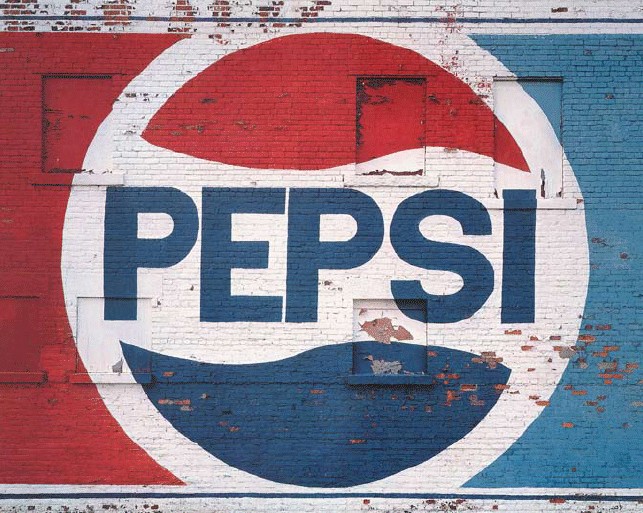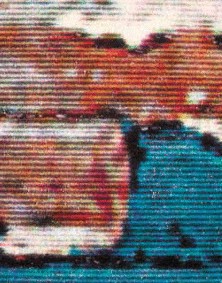- Relief printing
- Intaglio and planographic printing
- Color printing
- Bits and pieces
- Early photography in silver
- Non-silver processes
- Modern photography
- Color notes
- Color photography
- Photography in ink: relief and intaglio printing
- Photography in ink: planographic printing
- Digital processes
- Where do we go from here?
The Canon color copier

Canon color copier print. Richard Benson. Pepsi Sign. 1994. 10 x 12 5/8" (25.4 x 32 cm). The Museum of Modern Art, New York. Gift of Richard Benson © Richard Benson. To print in color, laser printers use toners in the subtractive primaries. The linear pattern of this print is an alternative to the conventional pattern of halftone dots. This print was made from a digital file produced by scanning an eight-by-ten-inch transparency.
In 1987 the Canon company produced a laser copier that made instant images in full color. As in the Xerox machine, the original was laid down on a flat scanning bed and the image was drawn by a laser, but in this case there were four separate drums—one each for cyan, magenta, yellow, and black—that had to have the appropriate static images built on them. Quite early on in the color copier’s life, firms were making computer interfaces for them that allowed them not just to copy a preexisting piece of flat art but to print a digital file. The image quality of these machines is quite high. The toners used are superb and very stable, and the images suffer mainly from an irregularly shiny surface—the toner deposit is often shinier than the paper support, leading to an odd, uneven reflectivity.

Detail of Canon color copier print. Richard Benson. Pepsi Sign. 1994. 10 x 12 5/8" (25.4 x 32 cm). The Museum of Modern Art, New York. Gift of Richard Benson © Richard Benson. The Canon color copier lays down its toner in a linear pattern, in which the intensity of the lines varies to create changes in tone and color. This detail is enlarged approximately twelve times from the original print.
Today all the small instant-print shops have versions of these color copiers, which are manufactured in a variety of brands and types. A few companies (Xerox, Canon, and Agfa among them) decided to turn the laser-driven color copier into a professional production machine, seeking out a market for high-end printing of books and small publications on demand, to avoid the need to produce large print runs before knowing whether or not a given publication would sell. This potential market is the same one that is pursued by the Indigo printer. Print-on-demand bookmaking languished for a while, although the technology was already available, but today many small printshops and university copy centers offer such a service.
If the binding and page sizes are standardized these small-edition publications can be quite inexpensive. I haven’t seen much original art done with color copiers, but prints made by these devices are everywhere. A good family snapshot might be copied to make a dozen or so for family members, or a unique watercolor might be copied and framed to be sold to tourists in some waterfront shop. The trouble with all this is that these prints are copies and decidedly inferior to the originals. The colors tend to be saturated, and they have often been falsely sharpened, but even so these second-generation prints are commonly mistaken for originals. Anyone collecting old prints should always bring a magnifying glass along to check that prints for sale are not just color copies. The detail on the previous page shows the fine parallel lines characteristic of the toner deposits from most of these copiers. The resolution on these machines is so fine that they can also emulate the traditional halftone, which gives them a better tonal scale, but with an obvious large halftone dot.

